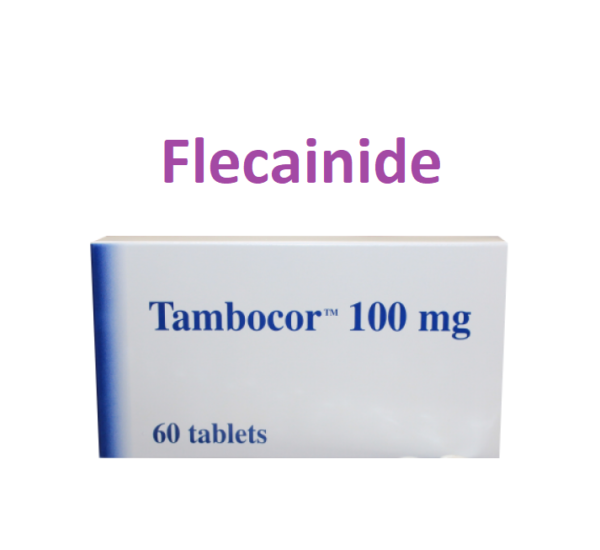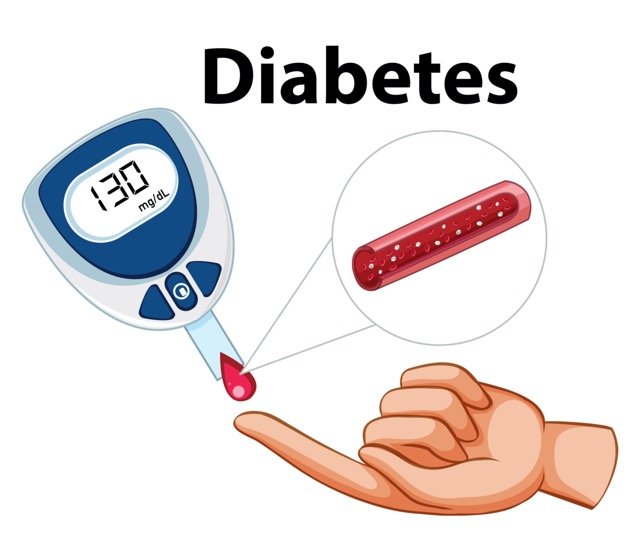Flecainide (Tambocor) is a class 1-C anti-arrhythmic drug that is used in the prevention of ventricular and supraventricular tachyarrhythmia in patients with a structurally normal heart.
Flecainide Uses:
-
Paroxysmal atrial fibrillation/flutter and paroxysmal supraventricular tachycardias (prevention):
- For the elimination of paroxysmal atrial fibrillation/flutter associated with disabling symptoms and paroxysmal supraventricular tachycardias (PSVT), including atrioventricular nodal reentrant tachycardia, atrioventricular reentrant tachycardia, and other supraventricular tachycardias of the unspecified mechanism associated with disabling symptoms in patients without structural heart disease.
- Guideline recommendations:
- Due to safety risks, flecainide should be reserved for symptomatic supraventricular tachycardias (SVTs) in patients without structural or ischemic heart disease who are not candidates for or prefer not to undergo, catheter ablation and in whom other therapies have failed or are contraindicated.
-
Prevention of Ventricular arrhythmias:
- Used for the prevention of documented life-threatening ventricular tachyarrhythmias (eg, sustained ventricular tachycardia) in patients without structural heart disease.
-
Guideline recommendations:
- It is an appropriate adjunctive therapy in patients with type 3 long QT syndrome or catecholaminergic polymorphic ventricular tachycardia who are already taking a maximally tolerated beta-blocker but still experiencing symptoms.
- Limitations of use:
- Flecainide is not recommended in patients with less severe ventricular arrhythmias, even if symptomatic.
- Because of the proarrhythmic effects of flecainide, its use should be reserved for patients in whom the benefits of treatment outweigh the risks.
- Flecainide should not be used in patients with chronic atrial fibrillation (not adequately studied) or recent MI.
- No evidence from controlled trials has demonstrated favorable effects of flecainide on survival or the incidence of sudden death.
-
Off Label Use of Flecainide in Adults:
- Used for ventricular premature beats
- Used for atrial fibrillation or flutter (pharmacologic cardioversion)
- Sustained fetal tachycardia
Flecainide (Tambocor) Dose in Adults
Flecainide (Tambocor) Dose in the treatment of sustained fetal tachycardia (maternal/ transplacental administration) (off-label):
- Oral: 100 to 300 mg per day in divided doses administered every 8 to 12 hours.
- Adjust the dose to the fetal response.
- Studies targeted maternal blood levels between 0.2 and 1 mcg/mL.
- The maximum dose: 450 mg per day.
Flecainide (Tambocor) Dose in the prevention of Ventricular arrhythmias:
- Oral: Initial: 50 to 100 mg every 12 hours;
- Increase the dose by 50 mg two times in a day at 4-day intervals;
- The maximum dose is 400 mg per day.
- Some patients inadequately controlled with or intolerant to dosing every 12 hours may require dosing every 8 hours.
Note:
- Initiate therapy in a hospital setting in patients with sustained ventricular tachycardia.
- The use of higher initial doses and more rapid dosage adjustments have resulted in an increased incidence of proarrhythmic events and congestive heart failure, particularly during the first few days.
- Do not use a loading dose.
Flecainide (Tambocor) Dose in the prevention of Paroxysmal atrial fibrillation & atrial flutter and paroxysmal supraventricular tachycardias:
- Oral: Initial: 50 mg every 12 hours;
- Increase the dose by 50 mg two times in a day at 4 day time period;
- The maximum total dose is 300 mg.
- The AHA/ACC/HRS atrial fibrillation guidelines recommend a maximum total daily dose of 400 mg.
Flecainide (Tambocor) Dose in the treatment of Ventricular premature beats (off-label):
- Oral: 50 to 200 mg every 12 hours.
- According to the prescribing information, may increase by 50 mg two times in a day at 4 day time intervals;
- The maximum dose is 400 mg per day.
Flecainide (Tambocor) Dose in the treatment of Atrial fibrillation or flutter (pharmacological cardioversion) (off-label dose): Oral:
Note:
- May be used on an outpatient basis (“Pill-in-the-pocket”).
- An initial inpatient cardioversion trial should have been successful before sending the patient home on this approach.
- Patient must be taking an AV nodal-blocking agent (eg, beta-blockers, non-dihydropyridine calcium channel blocker) prior to initiation of antiarrhythmic.
-
<70 kg:
- 200 mg;
- may not repeat in 24 hours.
-
≥70 kg:
- 300 mg;
- may not repeat in in 24 hours
-
Conversion from another antiarrhythmic agent:
- Allow for 2 to 4 half-lives of the other agent after discontinuation to pass before initiating flecainide therapy.
-
Dosage adjustment for concomitant therapy:
- Amiodarone: Reduce the flecainide dose by 50 percent and monitor the patient closely for adverse effects;
- monitoring of plasma concentrations is strongly recommended to guide dosage.
Flecainide (Tambocor) Dose in Childrens
Flecainide (Tambocor) Dose in the treatment of Arrhythmias:
-
BSA-directed dosing:
- Caution is used with dose titration, as small change in dose may result in disproportionate increase in plasma concentrations.
- Infants ≤6 months:
- Oral: Initial: 50 mg/m²/day divided every 8 to 12 hours;
- may titrate dose at 4 days time period;
- The maximum daily dose: 200 mg/m²/day;
- Higher doses have been associated with an increased risk of proarrhythmic effects.
- Infants >6 months, Children, and Adolescents:
- Oral: Initial: 100 mg/m²/day divided every 8 to 12 hours;
- The dose may be titrated at 4 days time period;
- The maximum daily dose is 200 mg/m²/day;
- Higher doses have been associated with an increased risk of proarrhythmic effects.
-
Weight-based dosing: Limited data available; dosing regimens variable:
- Infants, Children, and Adolescents:
- Oral: Initial: 1 to 3 mg/kg/day divided every 8 hours;
- may titrate dose at 4 days time intervals;
- The usual maintenance range: 3 to 6 mg/kg/day;
- An average effective dose of 4 mg/kg/day was reported in expert analysis of literature and clinical experience.
- The maximum daily dose: 8 mg/kg/day.
- Higher doses have been associated with an increased risk of proarrhythmic effects.
- Infants, Children, and Adolescents:
Flecainide (Tambocor) Pregnancy Category: B
- Flecainide crosses over to the placenta.
- For pregnant women suffering from supraventricular tachycardia, which is highly symptomatic, Flecainide can be used to manage their condition.
- It is best to use the lowest possible dose. If you can, avoid using during the first trimester.
- Use is also recommended for the prevention of SVT in patients with Wolff-Parkinson-White (WPW) syndrome.
- Flecainide can be used to prevent SVT in patients with WPW syndrome.
- Placental transfer does not decrease if fetal hemops is present.
- It is best to use the lowest possible dose. If you can, avoid using during the first trimester.
- There have been reports of abnormalities in the neonatal conduction.
- Maternal arrhythmias that are not treated can cause serious complications in both the mother and the fetus.
- Flecainide, which is administered maternally, may be considered to treat fetal SVT and atrial flutter (with hydrops) in utero.
- Flecainide can also be used to treat SVT without hydrops and ventricular dysfunction, if the heart beat is greater than 200 beats per minute or rare tachycardias that have an average heartbeat of over 200 beats per minute.
- Flecainide can also be used to treat fetal heart rhythm problems (VT) that have normal QTc, with or without hydrops.
- However, it is not recommended for treatment of VT in cases where long QT syndrome is suspected.
Use of flecainide during breastfeeding
- Breast milk can contain flecainide.
- Flecainide's relative infant dose (RID), is 8. percent. This was calculated by using the highest breast milk concentration and compared with a maternal dose of 200mg per day.
- When the RID of the medication is less that 10 percent, breastfeeding is generally acceptable.
- Flecainide's RID was calculated with a milk content of 1,529ng/mL. This gives an infant dose of 0.23 mg/kg/day.
- This milk concentration was achieved after maternal administration of oral flecainide 100mg twice daily for five days to eleven lactating women, starting the first day after birth.
- The breastmilk average and maternal plasma trough flecainide concentrations varied between subjects. However, the milk/plasma ratio was constant across the group.
- Flecainide concentrations in breast milk could be as high as 4x those found in maternal serum
- According to this study, milk concentrations will decline at the same rate that maternal serum concentrations after the medication is stopped.
Flecainide (Tambocor) Dose in Kidney Disease:
-
CrCl >35 mL/minute/1.73 m²:
- Initial: 100 mg every 12 hours; consider obtaining plasma concentrations to guide dosage adjustments.
- Dose increases should be made very cautiously at intervals of more than 4 days.
-
CrCl ≤35 mL/minute/1.73 m²:
- Initial: 100 mg once daily or 50 mg every 12 hours;
- Obtain plasma concentrations to guide dosage adjustments.
- Dose increases should be made very cautiously at intervals of more than 4 days and serum trough concentrations monitored frequently.
- In patients with end-stage renal disease, renal clearance is very low as compared to patients with moderate renal impairment, and the plasma half-life may extend up to 58 hours.
-
Hemodialysis:
- Removal by hemodialysis is negligible (only ~1% of an oral dose)
Flecainide (Tambocor) Dose in Liver disease:
- There are no dosage adjustments provided in the manufacturer’s labeling, however, elimination from the plasma may be slower in patients with hepatic impairment.
- Use with caution; obtain plasma concentrations to guide dosage adjustments.
- Dose increases should be made very cautiously at intervals of more than 4 days and serum concentrations should be monitored frequently.
- Frequent plasma level monitoring is required in patients with severe hepatic impairment; if unavailable, use is not recommended.
Common Side Effects of Flecainide (Tambocor):
-
Central nervous system:
- Dizziness
-
Ocular:
- Visual disturbances
-
Respiratory:
- Dyspnea
Less Common Side Effects of Flecainide (Tambocor):
-
Cardiovascular:
- Sinus Node Dysfunction
- Syncope
- Palpitation
- Chest Pain
- Edema
- Tachycardia
- Proarrhythmic
-
Central Nervous System:
- Hypoesthesia
- Paresis
- Ataxia
- Insomnia
- Depression
- Headache
- Fatigue
- Nervousness
- Fever
- Malaise
- Vertigo
- Somnolence
- Tinnitus
- Anxiety
-
Dermatologic:
- Rash
-
Gastrointestinal:
- Abdominal Pain
- Anorexia
- Diarrhea
- Nausea
- Constipation
-
Neuromuscular & Skeletal:
- Tremor
- Weakness
- Paresthesia
-
Ophthalmic:
- Diplopia
- Blurred Vision
Contraindications to Flecainide (Tambocor):
- Hypersensitivity to flecainide and any component of the formulation
- Pre-existing second- or third-degree AV block or right bundle branch block, when combined with a left-hemiblock (bifascicular bloc) (except for patients with an artificial pacemaker).
- Cardiogenic shock
- concurrent use of ritonavir
The American College of Cardiology/American Heart Association/European Society of Cardiology states that patients suffering from structural heart disease should not be given flecainide.
Warnings and precautions
-
Proarrhythmic effects: [US Boxed Warning]
- Proarhythmic effects (including increased premature ventricular contractions, ventricular tachycardia, ventricular fibrillation, and death) have been reported in patients with atrial fibrillation/fibrillation who received flecainide;
- Patients with chronic atrial fibrillation should not use this medication.
- Patients with ventricular tachycardia or serious underlying heart disease are at greater risk. Therapy should be initiated in a hospital setting.
- All patients can experience new or worsening supraventricular and ventricular arrhythmias with Flecainide; the dose is dependent.
-
Chronical atrial fibrillation:
- Patients with chronic atrial fibrillation should not use this medication. There is a greater risk of serious ventricular arrhythmias.
-
Atrial flutter
- Appropriate use: [US Boxed Warning]: When treating atrial flutter, 1:1 atrioventricular conduction may occur; preemptive negative chronotropic therapy (eg, digoxin, beta-blockers) may lower the risk.
-
Conduction disturbances:
- Rare cases of arrhythmias similar to torsade-de-pointes have been reported with flecainide.
- Dose-related rises in PR, QRS and QT intervals are common.
- Flecainide therapy should not be stopped if there is a second- or third degree AV block or right bundle branch block that is associated with a left-hemiblock.
- Patients with sick sinus syndrome should be cautious; flecainide treatment can cause sinus bradycardia or sinus pause.
-
Electrolyte imbalance:
- Before and during therapy, correct electrolyte imbalances, particularly hypokalemia and hypomagnesemia.
-
Heart disease
- The ACC/AHA/HRS recommends that patients suffering from structural or ischemic cardiovascular disease should avoid flecainide.
- Patients with heart disease should not use this medication. It can worsen or exacerbate the condition, increase the chance of pro-arrhythmia and increase the risk for death.
- The manufacturer advises that patients suffering from structural heart disease should be cautious as there is a greater risk of cardiac events and death.
-
Hepatic impairment
- Dose titration should only be done after the body has reached a stable state (>=4 days following initiation).
- Patients with severe hepatic impairment need to have their plasma levels monitored regularly. If this is not possible, it is best to discontinue use.
- Patients with severe hepatic impairment should be cautious. The benefits of this treatment should outweigh any potential risks.
- Take care to monitor your progress during therapy.
-
Renal impairment
- Patients with severe renal impairment should be cautious
- Patients with severe renal impairment should have regular plasma level monitoring; if this is not possible, it is not recommended.
Flecainide: Drug Interaction
Note: Drug Interaction Categories:
- Risk Factor C: Monitor When Using Combination
- Risk Factor D: Consider Treatment Modification
- Risk Factor X: Avoid Concomitant Use
Risk Factor C (Monitor therapy) |
|
| Antihepaciviral Combination Products | May increase the serum concentration of Flecainide. Management: Canadian labeling recommends avoiding this combination. |
| Carbonic Anhydrase Inhibitors | May increase the serum concentration of Flecainide. Exceptions: Brinzolamide; Dorzolamide. |
| CloBAZam | May increase the serum concentration of CYP2D6 Substrates (High risk with Inhibitors). |
| Cobicistat | May increase the serum concentration of CYP2D6 Substrates (High risk with Inhibitors). |
| CYP2D6 Inhibitors (Moderate) | May decrease the metabolism of CYP2D6 Substrates (High risk with Inhibitors). |
| Darunavir | May increase the serum concentration of CYP2D6 Substrates (High risk with Inhibitors). |
| Digoxin | Flecainide may increase the serum concentration of Digoxin. |
| Etravirine | May decrease the serum concentration of Flecainide. |
| Haloperidol | QT-prolonging Class IC Antiarrhythmics (Moderate Risk) may enhance the QTcprolonging effect of Haloperidol. Management: Monitor for QTc interval prolongation and ventricular arrhythmias when these agents are combined. Patients with additional risk factors for QTc prolongation may be at even higher risk. |
| Imatinib | May increase the serum concentration of CYP2D6 Substrates (High risk with Inhibitors). |
| Lacosamide | QT-prolonging Class IC Antiarrhythmics (Moderate Risk) may enhance the adverse/toxic effect of Lacosamide. Specifically the risk for bradycardia, ventricular tachyarrhythmias, or a prolonged PR interval may be increased. |
| Lumefantrine | May increase the serum concentration of CYP2D6 Substrates (High risk with Inhibitors). |
| Mirabegron | May increase the serum concentration of Flecainide. Management: Monitor clinical response to flecainide closely. Dose adjustment may be necessary. Canadian mirabegron labeling recommends restricting the maximum adult mirabegron dose to 25 mg/day in patients receiving flecainide. |
| Ondansetron | QT-prolonging Class IC Antiarrhythmics (Moderate Risk) may enhance the QTcprolonging effect of Ondansetron. Management: Monitor for QTc interval prolongation and ventricular arrhythmias when these agents are combined. Patients with additional risk factors for QTc prolongation may be at even higher risk. |
| Panobinostat | May increase the serum concentration of CYP2D6 Substrates (High risk with Inhibitors). |
| Peginterferon Alfa-2b | May decrease the serum concentration of CYP2D6 Substrates (High risk with Inhibitors). Peginterferon Alfa-2b may increase the serum concentration of CYP2D6 Substrates (High risk with Inhibitors). |
| Pentamidine (Systemic) | QT-prolonging Class IC Antiarrhythmics (Moderate Risk) may enhance the QTc-prolonging effect of Pentamidine (Systemic). Management: Monitor for QTc interval prolongation and ventricular arrhythmias when these agents are combined. Patients with additional risk factors for QTc prolongation may be at even higher risk. |
| Perhexiline | CYP2D6 Substrates (High risk with Inhibitors) may increase the serum concentration of Perhexiline. Perhexiline may increase the serum concentration of CYP2D6 Substrates (High risk with Inhibitors). |
| Pindolol | Flecainide may enhance the bradycardic effect of Pindolol. The negative inotropic effects of Pindolol may also be enhanced. |
| QT-prolonging Antidepressants (Moderate Risk) | QT-prolonging Class IC Antiarrhythmics (Moderate Risk) may enhance the QTc-prolonging effect of QT-prolonging Antidepressants (Moderate Risk). Management: Monitor for QTc interval prolongation and ventricular arrhythmias when these agents are combined. Patients with additional risk factors for QTc prolongation may be at even higher risk. |
| QT-prolonging Antipsychotics (Moderate Risk) | QT-prolonging Class IC Antiarrhythmics (Moderate Risk) may enhance the QTc-prolonging effect of QT-prolonging Antipsychotics (Moderate Risk). Management: Monitor for QTc interval prolongation and ventricular arrhythmias when these agents are combined. Patients with additional risk factors for QTc prolongation may be at even higher risk. Exceptions: Pimozide. |
| QT-prolonging Class IC Antiarrhythmics (Moderate Risk) | May enhance the QTc-prolonging effect of other QT-prolonging Class IC Antiarrhythmics (Moderate Risk). Management: Monitor for QTc interval prolongation and ventricular arrhythmias when these agents are combined. Patients with additional risk factors for QTc prolongation may be at even higher risk. |
| QT-prolonging Kinase Inhibitors (Moderate Risk) | QT-prolonging Class IC Antiarrhythmics (Moderate Risk) may enhance the QTc-prolonging effect of QT-prolonging Kinase Inhibitors (Moderate Risk). Management: Monitor for QTc interval prolongation and ventricular arrhythmias when these agents are combined. Patients with additional risk factors for QTc prolongation may be at even higher risk. |
| QT-prolonging Miscellaneous Agents (Moderate Risk) | May enhance the QTc-prolonging effect of QT-prolonging Class IC Antiarrhythmics (Moderate Risk). Management: Monitor for QTc interval prolongation and ventricular arrhythmias when these agents are combined. Patients with additional risk factors for QTc prolongation may be at even higher risk. Exceptions: Domperidone. |
| QT-prolonging Moderate CYP3A4 Inhibitors (Moderate Risk) | QT-prolonging Class IC Antiarrhythmics (Moderate Risk) may enhance the QTc-prolonging effect of QT-prolonging Moderate CYP3A4 Inhibitors (Moderate Risk). Management: Monitor for QTc interval prolongation and ventricular arrhythmias when these agents are combined. Patients with additional risk factors for QTc prolongation may be at even higher risk. |
| QT-prolonging Quinolone Antibiotics (Moderate Risk) | May enhance the QTc-prolonging effect of QT-prolonging Class IC Antiarrhythmics (Moderate Risk). Management: Monitor for QTc interval prolongation and ventricular arrhythmias when these agents are combined. Patients with additional risk factors for QTc prolongation may be at even higher risk. |
| QT-prolonging Strong CYP3A4 Inhibitors (Moderate Risk) | QT-prolonging Class IC Antiarrhythmics (Moderate Risk) may enhance the QTc-prolonging effect of QT-prolonging Strong CYP3A4 Inhibitors (Moderate Risk). Management: Monitor for QTc interval prolongation and ventricular arrhythmias when these agents are combined. Patients with additional risk factors for QTc prolongation may be at even higher risk. |
| Simeprevir | May increase the serum concentration of Flecainide. |
| Sodium Bicarbonate | May diminish the arrhythmogenic effect of Flecainide. Sodium Bicarbonate may increase the serum concentration of Flecainide. |
| Sodium Lactate | May increase the serum concentration of Flecainide. |
| Tobacco (Smoked) | May decrease the serum concentration of Flecainide. |
| Tromethamine | May increase the serum concentration of Flecainide. |
| Verapamil | May enhance the adverse/toxic effect of Flecainide. In particular, this combination may significantly impair myocardial contractility and AV nodal conduction. |
Risk Factor D (Consider therapy modification) |
|
| Abiraterone Acetate | May increase the serum concentration of CYP2D6 Substrates (High risk with Inhibitors). Management: Avoid concurrent use of abiraterone with CYP2D6 substrates that have a narrow therapeutic index whenever possible. When concurrent use is not avoidable, monitor patients closely for signs/symptoms of toxicity. |
| Amiodarone | May enhance the QTc-prolonging effect of Flecainide. Amiodarone may increase the serum concentration of Flecainide. Management: Decrease flecainide dose by 50%. Monitor for QTc interval prolongation and ventricular arrhythmias, and consider monitoring for elevated flecainide concentrations. Patients with additional risk factors for QTc prolongation may be at even higher risk. |
| CYP2D6 Inhibitors (Strong) | May decrease the metabolism of CYP2D6 Substrates (High risk with Inhibitors). |
| Dacomitinib | May increase the serum concentration of CYP2D6 Substrates (High risk with Inhibitors). Management: Avoid concurrent use of dacomitinib with CYP2D6 subtrates that have a narrow therapeutic index. |
| Domperidone | QT-prolonging Agents (Moderate Risk) may enhance the QTc-prolonging effect of Domperidone. Management: Consider alternatives to this drug combination. If combined, monitor for QTc interval prolongation and ventricular arrhythmias. Patients with additional risk factors for QTc prolongation may be at even higher risk. |
| QT-prolonging Agents (Highest Risk) | May enhance the QTc-prolonging effect of Flecainide. Management: Consider alternatives to this combination. Patients with other risk factors (eg, older age, female sex, bradycardia, hypokalemia, hypomagnesemia, heart disease, and higher drug concentrations) are likely at greater risk for these toxicities. Exceptions: Amiodarone. |
Risk Factor X (Avoid combination) |
|
| Asunaprevir | May increase the serum concentration of Flecainide. |
| Fosamprenavir | May increase the serum concentration of Flecainide. Management: Concurrent use of ritonavir-boosted fosamprenavir with flecainide is contraindicated. The use of nonritonavir-boosted fosamprenavir with flecainide is not specifically contraindicated but should only be undertaken with caution. |
| Pimozide | May enhance the QTc-prolonging effect of QT-prolonging Agents (Moderate Risk). |
| Ritonavir | May increase the serum concentration of Flecainide. |
| Tipranavir | May increase the serum concentration of Flecainide. |
Monitoring parameters:
Blood pressure, pulse, ECG, periodic serum trough concentrations, especially in patients with renal or hepatic impairment, concomitant administration of amiodarone, and pediatric patients.
How to administer Flecainide (Tambocor)?
Oral: When used for the management of fetal tachycardia (maternal/transplacental administration; off-label use), oral doses are administered to the mother.
Mechanism of action of Flecainide (Tambocor):
- It is a Class Ic antiarrhythmic medication that slows the conduction of cardiac tissue through altering the transport of ions across cell membranes.
- It can prolong refractory periods slightly and reduce the rate of rising the action potential, without affecting its duration.
- It also increases electrical stimulation threshold in the ventricles and the His Purkinje system.
- It has moderately negative inotropic and local anesthetic effects.
Absorption:
- Oral: Nearly complete;
- Absorption is decreased when administered with milk.
Protein binding:
- About 40%
Half-life elimination:
- Newborns: Up to ≤29 hours;
- 3 months: 11 to 12 hours;
- 12 months: 6 hours
- Children: ~8 hours
- Adolescents 12 to 15 years: ~11 to 12 hours
- Adults: ~20 hours (range: 12 to 27 hours);
- The half-life elimination is increased in patients with heart failure (NYHA Class III) or renal dysfunction
Time to peak, serum:
- About 3 hours (range: 1 to 6 hours)
Excretion:
- Urine (30% [range: 10% to 50%] as unchanged drug);
- feces (5%)
International Brand Names of Flecainide:
- Auro-Flecainide
- Tambocor
- APO-Flecainide
Flecainide Brand Names in Pakistan:
No Brands Available in Pakistan.







